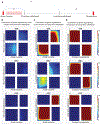The transcriptional response to acute cocaine is inverted in male mice with a history of cocaine self-administration and withdrawal throughout the mesocorticolimbic system
- PMID: 36868542
- PMCID: PMC10247534
- DOI: 10.1016/j.mcn.2023.103823
The transcriptional response to acute cocaine is inverted in male mice with a history of cocaine self-administration and withdrawal throughout the mesocorticolimbic system
Abstract
A large body of work has demonstrated that cocaine-induced changes in transcriptional regulation play a central role in the onset and maintenance of cocaine use disorder. An underappreciated aspect of this area of research, however, is that the pharmacodynamic properties of cocaine can change depending on an organism's previous drug-exposure history. In this study, we utilized RNA sequencing to characterize how the transcriptome-wide effects of acute cocaine exposure were altered by a history of cocaine self-administration and long-term withdrawal (30 days) in the ventral tegmental area (VTA), nucleus accumbens (NAc), and prefrontal cortex (PFC) in male mice. First, we found that the gene expression patterns induced by a single cocaine injection (10 mg/kg) were discordant between cocaine-naïve mice and mice in withdrawal from cocaine self-administration. Specifically, the same genes that were upregulated by acute cocaine in cocaine-naïve mice were downregulated by the same dose of cocaine in mice undergoing long-term withdrawal; the same pattern of opposite regulation was observed for the genes downregulated by initial acute cocaine exposure. When we analyzed this dataset further, we found that the gene expression patterns that were induced by long-term withdrawal from cocaine self-administration showed a high degree of overlap with the gene expression patterns of acute cocaine exposure - even though animals had not consumed cocaine in 30 days. Interestingly, cocaine re-exposure at this withdrawal time point reversed this expression pattern. Finally, we found that this pattern was similar across the VTA, PFC, NAc, and within each brain region the same genes were induced by acute cocaine, re-induced during long-term withdrawal, and reversed by cocaine re-exposure. Together, we identified a longitudinal pattern of gene regulation that is conserved across the VTA, PFC, and NAc, and characterized the genes constituting this pattern in each brain region.
Keywords: Craving; Dorsal striatum; Gene expression; Incubation; RNA-sequencing; Ventral striatum.
Copyright © 2023 Elsevier Inc. All rights reserved.
Conflict of interest statement
Declaration of competing interest The authors have no competing interests.
Figures




References
-
- Bagot RC, Cates HM, Purushothaman I, Lorsch ZS, Walker DM, Wang J, Huang X, Schlüter OM, Maze I, Peña CJ, Heller EA, Issler O, Wang M, Song W-M, Stein JL, Liu X, Doyle MA, Scobie KN, Sun HS, … Nestler EJ (2016). Circuit-wide Transcriptional Profiling Reveals Brain Region-Specific Gene Networks Regulating Depression Susceptibility. Neuron, 90(5), 969–983. 10.1016/j.neuron.2016.04.015 - DOI - PMC - PubMed
-
- Bagot RC, Cates HM, Purushothaman I, Vialou V, Heller EA, Yieh L, LaBonté B, Peña CJ, Shen L, Wittenberg GM, & Nestler EJ (2017). Ketamine and Imipramine Reverse Transcriptional Signatures of Susceptibility and Induce Resilience-Specific Gene Expression Profiles. Biological Psychiatry, 81(4), 285–295. 10.1016/j.biopsych.2016.06.012 - DOI - PMC - PubMed
-
- Bilbao A, Parkitna JR, Engblom D, Perreau-Lenz S, Sanchis-Segura C, Schneider M, Konopka W, Westphal M, Breen G, Desrivieres S, Klugmann M, Guindalini C, Vallada H, Laranjeira R, de Fonseca FR, Schumann G, Schütz G, & Spanagel R (2008). Loss of the Ca2+/calmodulin-dependent protein kinase type IV in dopaminoceptive neurons enhances behavioral effects of cocaine. Proceedings of the National Academy of Sciences of the United States of America, 105(45), 17549–17554. 10.1073/pnas.0803959105 - DOI - PMC - PubMed
Publication types
MeSH terms
Substances
Grants and funding
LinkOut - more resources
Full Text Sources
Miscellaneous

